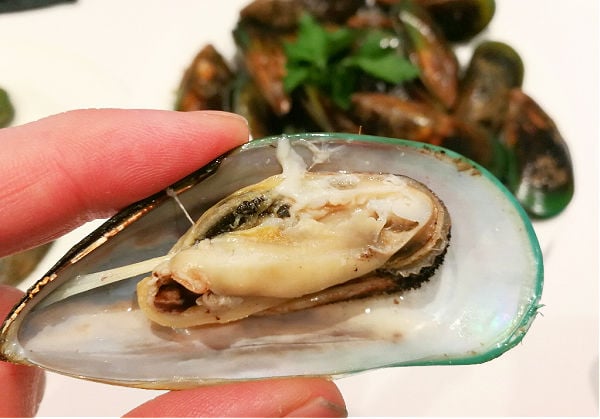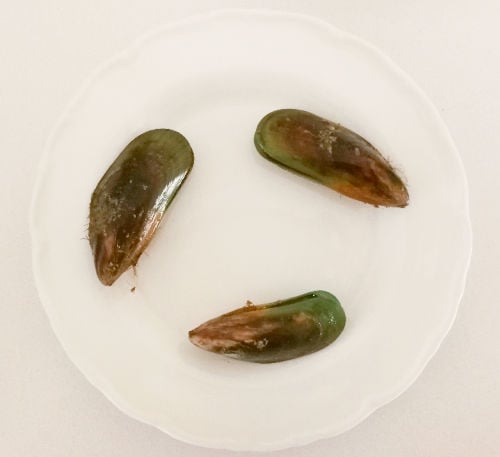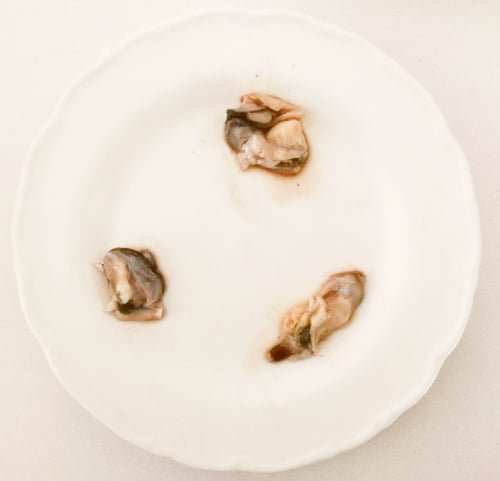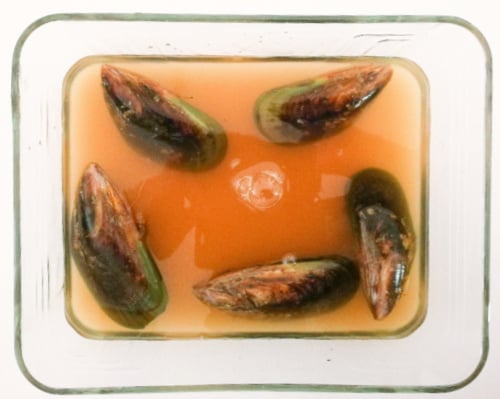Mussels are a readily available type of seafood that's best steamed or tossed into a dish at the end of the cook. Having recently tested whether cookie dough, milk, and Eggos are suitable for the microwave, our thoughts turned to mussels.
We bought a small wheelbarrow full of New Zealand Green Lip mussels and got busy cooking. This is what our testing revealed.
Are mussels suitable for microwaving?
After testing three different cooking methods, we found that mussels are suitable for microwaving. They are best cooked on a flat microwave-safe plate in their shells. Although timings will vary by oven, try heating them for about two minutes on high.
The team was pleasantly surprised by the results of cooking mussels in the microwave oven. We guessed that they’d be tough and unevenly cooked, but they had reasonable levels of juice and were tender. Using conventional cooking techniques will provide a slightly better result, but the difference isn't huge.

A mussel cooked with its shell on in the microwave.
How to microwave mussels
Let’s take a closer look at the three cooking methods and how they rated.
1. Microwaving with shells on

Evenly space the seafood around the outside of the plate.
This was the easiest option of the three and also our favorite. If you’re using live mussels then soak them in a bowl of water for twenty minutes. They’ll expel sand and salt, resulting in a tastier mussel.
- Evenly place three mussels around the outside of a plate. Don’t place any in the middle of the dish as they’ll cook faster than the others.
- Cook on high for 30 seconds and then check if they’re ready. A sign that they’re cooked is when the shells open.
- You’ll probably need to continue heating for a further half-minute and check again. Heat in shorts bursts until they’re cooked.
- Season and serve with garlic butter sauce, white wine sauce, or add to your favorite seafood pasta dish.
Result: 8/10
You’ll get evenly cooked mussels that barely taste different from steamed mussels.
2. Microwaving with shells off

Mussels look unpleasant without their shells.
This cooking method was similar to the first but required a little more work up-front removing the shells. Once you have the meat ready, follow the steps from the first method above.
You won’t be able to use the shells as an indicator of whether they’re cooked. Instead, the mussel meat must reach an internal temperature needs to reach 145°F.
Tip: Be exact with measuring the temperature of your mussels. Eating undercooked mussels is a health risk. If you don’t have an internal thermometer then avoid this method.
Result: 6/10
The mussels tasted good, although a little tougher than when they were cooked in their shells. They don’t look appealing out of their shells, and we can’t think of a good reason for using this method.
3. Microwaved immersed in a liquid

Cooking in liquid is a much slower method.
We had high hopes for this technique as it felt like they’d turn out moister. We cooked the seafood in stock, but you could use any liquid like wine, broth, or water.
Using a microwave-safe deep dish, add mussels in a single layer then pour enough liquid to cover the seafood. We used 3 cups of seafood stock.
Heating times will vary depending on the microwave and the amount of liquid used, but it will take roughly 12 minutes to cook the mussels. The mussels are ready when the shells open.
Result: 5/10
These mussels didn’t taste any better than simply microwaving them in their shells with no liquid. Not going to lie, it was a little frustrating. Considering the cooking time was a lot longer and there was the additional cost of using stock, the result didn’t justify the extra time or expense.

Frequently asked questions
How do I reheat mussels in the microwave?
Mussels will quickly turn rubbery and tough if they’re reheated for too long in the microwave. If the mussels are mixed into other ingredients, such as a seafood pasta dish, remove them and set them aside. Heat the rest of the dish until very hot, then reheat the mussels for 30-60 seconds. Make sure they are heated through, then mix back into the other food.
How do I store mussels?
Mussels are best kept in the refrigerator for 2-3 days. They can be stored in a bowl with a damp paper towel or cloth over the top. It is important to drain out any liquid from the bottom of the bowl to maximize freshness.
Can I freeze mussels?
Mussels can be frozen for 2-3 months in an airtight container. Always label them before freezing to avoid any confusion about how long they’ve been in the freezer.
How do I tell if mussels are bad?
Mussels that are slimy or have a pungent, fishy smell should be discarded. When cooking fresh mussels, if the shells don’t open it’s also a sign that they are dead and should be disposed of.
Related reading:
Are frozen fries okay to microwave?
Summing up
These results are sure to be helpful for super-busy households who want to skip slower cooking methods; it’s also handy knowledge for anyone who doesn’t have access to an oven.
Coming into this cooking experiment, we were adamant that microwaved mussels would be a dry disappointment. We’re happy to say that wasn't the case. Mussels turn out moist and full of flavor when zapped in a microwave.
Should you use the microwave as your preferred method of cooking? No. Steaming or tossing into a hot pan for a few minutes are better options. The seafood juices have a better chance to get incorporated into the other food. There is also a higher risk of over-cooking the mussels when microwaved. Only use the microwave if you’re in a pinch.

Leave a Reply